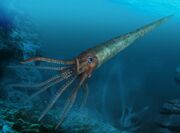
The cone-headed octopus (Orthoceras gyros, name meaning "gyrating straight horn"), also known as the cone-headed nautilus and the orthocone, is a species of cephalopod that originally lived in the middle Ordovician as extinct species of Orthoceras and were once extinct, but has since been brought back from extinction by SciiFii and introduced to the modern Atlantic and Indian oceans to help boost biodiversity. The cone-headed octopus has a slender, elongate shell with the middle of the body chamber transversely constricted, and a subcentral orthochoanitic siphuncle. The surface is ornamented by a network of fine lirae. It has several tentacles, which, unlike the tentacles of other cephalopods like the cuttlefish and the squid, doesn't range in size, but are of a generally similar length and these tentacles don't have suction cups, but rather the tentacles are ridged on their inner side. In the center of its face is a large, sharp, parrot-like beak that is used to crush through carapaces of such arthropods like Megalograptus. It has large, primitive eyes which are sensitive to contact with bright lights, so the cone-headed octopus prefers to live in darker waters. At the bottom of the animal is a tube-shaped organ called a hyponome. This is used to propel the animal through the water. The cone-headed octopus is the apex predator among other cephalopods, feeding on any animal smaller than itself, including the "true" octopuses, squid, etc, but also other animals like small pinnipeds, fish, sea turtles, etc. The conservation status of the cone-headed octopus is Least Concern due to successful conservation efforts and the cone-headed octopus' wide range.
